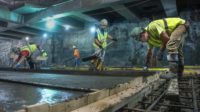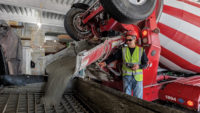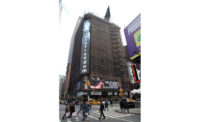A plant that recycles and processes glass to create a component for greener concrete opened Dec. 11 in Connecticut, after the company proved its concept on several New York City projects and could be among other businesses to qualify for incentives included in bills pending in the New York State legislature.
Pozzotive, a ground glass pozzolan, can replace up to 50% of the cement for concrete, says Patrick Grasso, a partner at Urban Mining Northeast, which has partnered on the product with the family of Ray Oneglia, vice chairman of materials and concrete supplier O&G Industries.
Pozzolans are a broad class of materials that help in binding concrete and include fly ash and silica fume. Grasso says his product is a particularly green option since fly ash comes from coal-fired power plants, and also because his factory will process the glass itself rather than obtain it rom an outside recycler.
“We created a process to clean the glass to a very high standard,” Grasso explains, “and then process it into a very fine powder”—the pozzolan.
Recycled glass pozzolan is among many innovations that would benefit from bills A08617 in New York’s Assembly and S8965 in the state Senate, amendments to state finance and tax laws, which aim to incentivize use of low-embodied-carbon-concrete, also called LECC, in public construction projects via tax credits and price discounts. The bills are expected to be reintroduced in the legislative session that starts in January.
The proposed amendments cite replacing clinker content in the “cement component” of concrete with “lower-carbon-intensive alternative materials” including “recycled ground-glass pozzolan.”
Reducing Carbon Footprint
“Many diverse pozzolan products that have long been used in concrete” also provide benefits, “including reduced carbon footprint,” says Rick Bohan, vice president of sustainability at the Portland Cement Association.
The proposed amendments would also reward other solutions, explains a spokesperson for Assembly member Robert Carroll, sponsor of the bill in that chamber. A tax credit would be applied against the one-time cost that providers of concrete or concrete components would incur when adopting technology that can provide an Environmental Product Declaration, or EPD— information about the life cycle impact of a product.
The amendments would also establish a general climate performance-based discount of up to 5% for a wide variety of emissions-reductions solutions, including higher efficiency or low-carbon fuel at plants, mineralizing carbon in concrete materials, and use of locally made products, which would reduce shipping distances and thus transportation emissions.
The bills also offer a supplemental price discount for carbon capture and utilization storage (CCUS), which removes carbon dioxide emitted at factories or plants, then stores and deposits it so it cannot get into the atmosphere.
While a law should not preclude innovations, policy experts say CCUS is important to include because the process is crucial to attaining net zero emissions.
Meghan Lewis, a senior researcher at the Carbon Leadership Forum in Washington state and chair of the building focus group of the Embodied Carbon Network, points to a recent report from the International Energy Agency. She says the IEA “found that CCUS is the biggest part of the solution for mitigating CO2 emissions for the cement sector, followed by avoided demand and changing the clinker-to-cement ratio.”
The IEA “estimates that up to 48% of cement emissions reductions will have to come from CCUS,” Carroll’s spokesperson adds.
Still, Lewis notes, CCUS “does not directly tie the initiatives to low-carbon products.” In other words, it doesn’t directly spur innovations. And such products, which have what the New York bills call lower global warming potential (GWP), could have a lower carbon footprint than a product using CCUS technology—yet both could get the same bid incentive.
A “performance-based” law would be “technology-agnostic and reward the lowest GWP product,” Lewis says.
Several cities around the U.S. have laws or programs promoting low-embodied-carbon concrete. Marin County, Calif., adopted a building code, effective early this year, that seems to go furthest: Rather than offering tax or price incentives, it specifically requires limited carbon emissions from concrete. In Seattle, the city’s Green Building Standard offers expedited permitting for projects that meet embodied carbon criteria.
Good Timing
“Timing is just perfect, given where we are as a country and a society,” Oneglia says about the Pozzotive factory in Beacon Falls, Conn., which opened with a virtual ribbon cutting ceremony due to COVID-19 distancing concerns.
Also timely: the ASTM-C1866 standard specification for ground glass pozzolan used in concrete, was published in March this year. Bohan says: “With the adoption of that specification, we expect to see others enter the market for this particular product.”
But Pozzotive has been in the works for about a decade, started by Grasso’s brother and Oneglia’s cousin. Before building the factory, Grasso says, they made the ground glass as needed for specific projects, and it’s now been used in more than 10 million concrete masonry units, 750,000 sq ft of pavers and 500,000 sq ft of pre-stressed concrete planks and blocks in New York City projects including the United Nations Plaza, a Whole Foods market and Second Avenue Subway stations.
The new factory’s green benefits go beyond creating low-carbon concrete, Grasso says. It can clean and process any type of glass in the recycling stream, including CRT panel glass, even if it’s contaminated by Pyrex or ceramics. He adds that two-thirds of post-consumer glass ends up in landfills, but Pozzotive will be able to recycle and reuse any of that material.
In turn, the product, whose factory is located about 80 miles from New York City, can help area contractors achieve greener projects and possibly qualify for transportation distance-related and other incentives if New York state lawmakers take action on the proposed bills next year.





